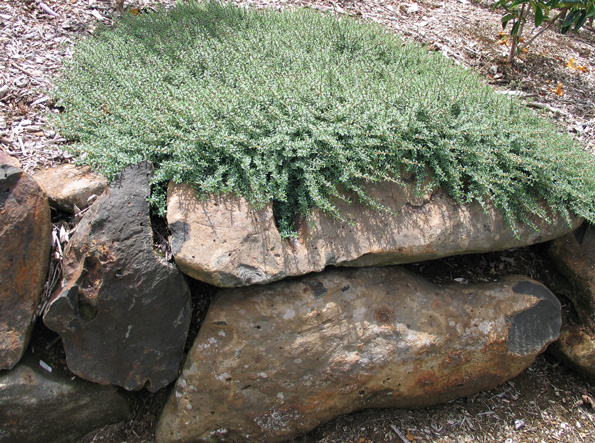This is a hilly country, to which gardeners from Dunedin, Wellington, west Auckland and any one of a million other places will attest. Where there are hills, there are banks, which present some serious landscaping challenges. Getting up and down them without sliding on your backside is just the beginning.
Most folk don’t have much of an idea of what to do with banks, so they often end up with a sort of no-man’s land that nobody wants to deal with. Anything you put on them, apart from deep-rooted plants, will be on a mission to get to the bottom, so soil, lime chip, stones and gravels will eventually accumulate at the bottom – unless you can find a way to stop it on the way down.
The most common solution is to plant ground covers, but that’s a long-term and often expensive cover-up. Unless you’ve got plenty of dosh to spend on plants, it’s no quick fi x. Turning banks into attractive, manageable areas is often a tricky, slow process, and in many situations it pays to call in the cavalry right at the outset.
If a landscape architect is within your budget, it’s the most effective way to go, but it’s by no means impossible to do at least some of the job yourself and project-manage any contractors you need. The first line of defence is probably going to be some kind of retaining wall, and that’s not often a DIY project. If you need a strong, high wall for an erosion problem waiting to happen, it’ll pay to call on a professional.

Simple terracing jobs, on the other hand, are excellent DIY landscaping projects. After building small stone or timber retaining walls, you can plant behind them. Before you start, you need to be aware of some of the characteristics of banks. On the negative side, there’s the safety factor. Sliding down the bank on your bum is both inelegant and unsafe, so you have to create some flat spaces.
Then there’s the problem of low infiltration. On flat or relatively flat ground, water has a longer time to soak in before runoff occurs. As the slope increases, runoff occurs more quickly and infi ltration therefore decreases, so you’ll have to organise watering and select suitable plants.
Another issue with slopes is retaining mulch. Just as fertiliser, herbicides, soil, gravel and water are prone to tumbling down the slope; mulch also has a hard time staying put. The positive characteristics of banks are somewhat fewer: a well-designed and maintained slope can be a wonderful accent or backdrop, giving your property added drama and interest – that’s the only one I can think of.
Retaining the slope is certainly the first step. A series of small terrace walls can be an attractive, environmentally kind solution to your bank problem rather than a massive reinforced wall. Small rock or interlocking walls allow rainfall to stay on the landscape slope and you can garden on the terraces. Sometimes the bank can be made usable by cutting garden paths across the slope. It breaks up the space, giving access to areas which need work done.

If you’re doing it yourself, timber will be the likely material. Flat paths, steps and seating spaces can be created to ease the slope and retained with timber or railway sleepers. Rocks are also great for banks, but you’ll need to dig them in so they don’t roll to the bottom, and also to give them a settled look. We’re talking rocks here, so you’ll need a creative person with a little digger.
Hundreds of plants are potentially suitable as ground covers for slopes, depending on the site and your region. The big advantage is that they don’t need to be mowed, so forget that vision of yourself chasing the mower downhill. For a design with a bit of form, the planting needs to be a mix of ground covers, shrubs, trees, and perennials. It’s also recommended to mix up plants with deep roots and shallow roots.
Deeper-rooted plants are needed to tie the top soil(s) to the bottom rock, but the top 30-60cm of soil needs to be tied tightly together. Most slopes can be made relatively stable with plants. Cheer yourself with the thought that you don’t often see naked banks in nature.

Planting tips
When you’re planting in dodgy environments, it’s not a bad idea to use natives as your main plants. If you’re worried this won’t give you enough design options, just go to arc.govt. nzand look at the diagram of clay bank vegetation – it demonstrates how to achieve different heights on your bank and is something you can adapt for your own situation.
Group smaller plants, such as grasses, in clumps of five or seven. They look more natural, and you can split them if they overgrow.
Shrubs and trees can stand alone, but again, if you want to group them, go for uneven numbers.
Many natives can become fantastic design features and will provide movement in the wind. Add some contrast with mounds of hebe, glossy coprosmas and pachystegia, and include spikes of lancewood and bold flaxes.
Some suggestions:
Carex testacea
Poa cita
Pseudopanax crassifolius
Marlborough rock daisy (Pachystegia rufa)
Hebe topiaria
Sophora “Dragons Gold” (dwarf kowhai)
Coprosma “Karo Red”
Libertia (native iris)
Phormium cookianum
Geranium traversii



